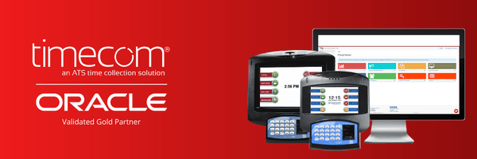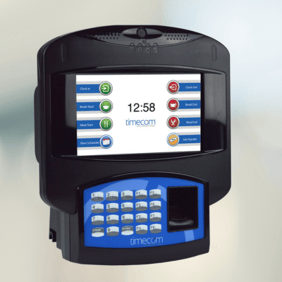Your company deserves a time clock solution that integrates easily with your Oracle Time and Labor Project. Equally as important - it must provide significant added value to your workforce management solution.
We’ll provide you with a step-by-step guide that will help you pick the right time clock company to integrate with your Oracle Time and Labor software.
By following these steps, you’ll partner with a solution provider that accounts for costs and delivers benefits across your organization, including helping to streamline your project management responsibilities.
Selecting the Right Time Clock Company
You want a vendor you can rely on. You’re not just selecting a solution when you pick a time clock system to integrate your Oracle software. You’re selecting a relationship that should continue to provide value.

Look for an Oracle-Verified Vendor
The first required step is to filter out options that aren’t Oracle-verified. You want to choose a solution that you know Oracle has reviewed, tested, and confirmed. These solutions have met Oracle’s performance and security standards.
Going with an Oracle-verified solution lowers your risk of selecting a solution that becomes costly or unreliable because it doesn’t integrate well with Oracle. You know that the solution and its integration is already built and proven. You can be confident that integration and implementation will go smoothly and without the project costing more than expected or suffering delays.
Use this link to discover how to find an oracle verified time clock partner.
Questions to Ask a Potential Oracle Time Clock Vendor
You want to ask several questions to vet a potential vendor, even one that’s Oracle-verified.
How flexible are their configuration options?
- Does it only accept shift entry and exit punches, or can it submit other work-related punches, like meal and rest breaks?
- Does it have different software configurations available to set different rule groups for various units or departments?
- Does the vendor have a record of continuous innovation so you know the system will evolve with your business and new technologies?
What additional services does the vendor provide?
- What service level agreements (SLAs) are offered to ensure maximum up-time and responsive support?
- Does the vendor deliver your clocks to you fully configured to your specification, or is your IT team responsible for configuring all of them?
- What support does the vendor provide for clock updates and replacements?
Selecting the Right Time Clock System
You want a comprehensive time clock solution that extends the power of your Oracle projects. Here are four feature areas to investigate as you compare systems.
Moving Beyond the Timecard
The time clock system should offer you a variety of reader configuration options so you can select the one that best suits your organization.
Keypad
The clock should always include a keypad option (digitally on screen or physically on the clock) so employees can always punch in with their employee identification number as a backup. This isn’t an optional step if you want to use a biometric reader, as some jurisdictions require employers to allow employees to opt out of a biometric program.
the clock) so employees can always punch in with their employee identification number as a backup. This isn’t an optional step if you want to use a biometric reader, as some jurisdictions require employers to allow employees to opt out of a biometric program.
Proximity readers
The other common reader options that should work with the time clock are barcode readers, swipe cards, and proximity (RFID) readers. They provide a convenient and efficient way for employees to clock in and out of work. With a simple swipe or tap of the badge near the time clock, employees can quickly send their attendance data to Oracle, saving valuable time for both them and the workplace. Link to: Oracle Time and Labor Timecard
Advanced Features and Functionality
The time clock should have features that enable the following types of advanced functionality that streamline managers' time management processes.
Features that Facilitate Communication
The most important feature for providing employees with a low friction, fast user experience is a wide, high definition, touchscreen. A screen like this displays large buttons and easy-to-read messages for improved employee communication.
Employee Self-Service (ESS) at the Time Clock
A time tracking system that shares bi-directional data between the clock and Oracle Time and Labor gives you the advantage of letting employees search for their scheduling and other information at the clock without having to ask project managers or payroll staff.
They should also be able to submit time off requests for approval at the clock.
Time Clock Durability
The usable life of the clock is critical to manage the cost of the system. The average time clock lasts just two to three years, which increases the total cost of ownership of the whole system.
In contrast, a well-designed, well-constructed time clock, like those manufactured by ATS, can last for almost a decade.
Time Clock Reliability
You need the time clocks to operate reliably to maintain full cycle automation from time entry and exit data collection to data delivery to Oracle and all back-office software. Unreliable clocks cost time and money in workarounds and potential human data entry errors.
Additional Resources
How Do I Choose the Best Time Clock for My Business
What ROI Can I Expect by Investing in a High Quality Time Clock
Manage Project Costing with a Scalable Solution
Your company needs a time clock system that is cost-efficient to configure, integrate, and deploy. Yet, it must also remain easy and cost-efficient to manage as your business - and time clock deployment - grows.

Purpose-built Time Clock System and Integration
Selecting a time clock system purpose built to integrate with Oracle Time and Labor minimizes the expenditure on integration and deployment. It also speeds up the process from configuration to go-live. Our TimeCom cloud-based solution is built to easily integrate into your Oracle time and labor software with any one of our TimeCom time clocks, this Oracle process only takes between six to eight weeks.
Link to: Overcoming the Challenges of Oracle Time and Labor Implementation
Cloud-Based Time Clock Management: Affordable Costs with High Service Level
Having a centralized time clock management tool enables your IT Team to support a growing time clock fleet without needing additional personnel. In our TimeCom system, we provide our clients with ClockWatch, our web-based application that IT teams use to monitor connectivity and data integration.
As a cloud-based system, TimeCom uses its middleware to remotely push out time clock software and security updates. We coordinate with your support team to update your entire clock fleet in a single step without having to touch any of the clocks.
Amplify the Value of Your Oracle Time and Labor Project
Integrating your Oracle Time and Labor project with a proven Oracle-verified solution like TimeCom helps you create a powerful suite of workforce management tools. Contact us today to learn how integrating with the right time clock solution increases your return on your Oracle investment.







